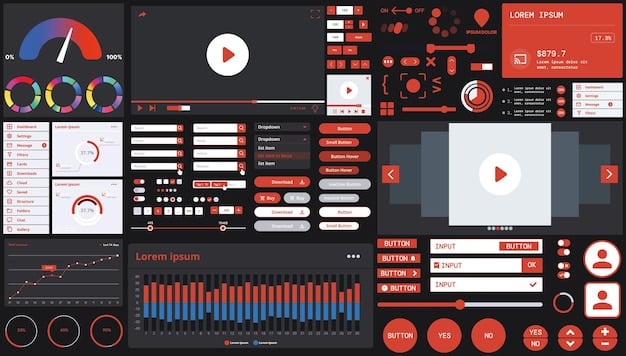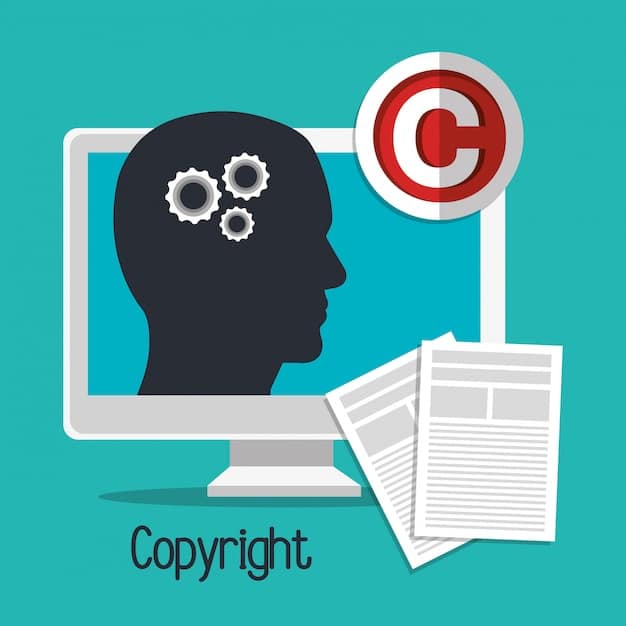YouTube’s New Copyright Rules: Protecting Your Content in the US

YouTube’s New Copyright Rules: Protect Your Content in the US are crucial for content creators to understand. These rules outline how YouTube handles copyright infringement, disputes, and content protection within the United States.
Navigating the complexities of copyright on YouTube can be daunting. YouTube’s New Copyright Rules: Protect Your Content in the US are designed to offer safeguards for creators and rights holders alike, but understanding how these rules work in practice is essential for anyone with a channel. This article will break down the most important aspects of these regulations.
Understanding YouTube’s Copyright System
YouTube’s copyright system is built to balance the interests of copyright holders and content creators. It’s a complex framework that addresses copyright infringement claims, content ID, and the overall protection of intellectual property on the platform. This ensures a fair environment for everyone involved.
What is Content ID?
Content ID is YouTube’s automated system used to identify and manage copyrighted content. It allows copyright owners to scan videos for matches to their copyrighted works.
- Matching: When a video is uploaded, it’s scanned against a database of copyrighted material.
- Options for Copyright Holders: If a match is found, copyright holders can choose to monetize, track, or block the infringing content.
- Dispute Process: Users who believe their video was incorrectly flagged can file a dispute.
Content ID provides a powerful tool for copyright holders to protect their content. However, it’s also important for creators to understand how the system works to avoid unintentional copyright strikes.
In essence, understanding YouTube’s broader copyright system, including Content ID, is crucial for any content creator. It helps avoid potential issues and ensures compliance with US copyright laws, making the platform safer and more sustainable for all.

Navigating Copyright Strikes Under YouTube’s New Copyright Rules: Protect Your Content in the US
Copyright strikes are a significant concern for YouTube creators, as they can lead to serious repercussions, including video removal and account termination. YouTube’s New Copyright Rules: Protect Your Content in the US provide a framework for addressing copyright infringement effectively.
What is a Copyright Strike?
A copyright strike is issued when a copyright holder submits a complete and valid legal takedown request for a video that infringes their copyright. Understanding the implications of these strikes is paramount.
- Consequences: Receiving a copyright strike can result in the removal of the infringing video.
- Three-Strike Policy: If a channel receives three copyright strikes, it will be terminated.
- Counter Notification: If you believe a strike was issued in error, you can submit a counter notification.
Understanding the nuances surrounding copyright strikes and the potential ramifications they carry is vital for ensuring the longevity and integrity of your YouTube channel.
Navigating the intricacies of copyright strikes and how YouTube’s New Copyright Rules: Protect Your Content in the US influence outcomes can significantly affect a creator’s experience on the platform. Being knowledgeable about this aspect of YouTube is essential for long-term success.

Fair Use and YouTube: What You Need to Know
Fair use is a legal doctrine that allows the use of copyrighted material without permission from the copyright holder under certain circumstances. Understanding fair use is essential for avoiding copyright issues on YouTube.
The Four Factors of Fair Use
The determination of fair use involves a consideration of four factors, as outlined by US copyright law:
- Purpose and Character of the Use: Whether the use is transformative, adding new expression or meaning to the original work.
- Nature of the Copyrighted Work: Using factual works is more likely to be considered fair use than using creative works.
- Amount and Substantiality: Using only a small portion of the original work increases the likelihood of fair use.
- Market Effect: The use should not negatively impact the potential market for or value of the copyrighted work.
These four factors are weighed together, and no single factor is determinative.
Analyzing situations through the lens of fair use, while adhering to YouTube’s New Copyright Rules: Protect Your Content in the US, provides content creators with a balanced approach to utilizing copyrighted material without infringing upon established laws. Doing this skillfully can lead to both creativity and compliance.
Steps to Protect Your Content on YouTube in the US
Protecting your original content on YouTube is vital to prevent unauthorized use and maintain control over your intellectual property. There are several steps you can take to safeguard your work within the US legal framework and according to YouTube’s policies.
Watermarking Your Videos
Adding a watermark to your videos is a simple but effective way to deter unauthorized use.
- Branding: Use your channel logo or name as a watermark.
- Placement: Position the watermark in a visible but unobtrusive location.
- Transparency: Adjust the transparency so the watermark doesn’t distract from the content.
Watermarking offers a visually assertive layer of protection, signaling ownership to potential infringers and viewers alike.
Applying these measures diligently aligns with YouTube’s New Copyright Rules: Protect Your Content in the US, bolstering your prospects for effective content protection in the digital landscape.
Monetization and Copyright: Staying Compliant
Monetization is a key goal for many YouTube creators. However, it’s crucial to ensure that your content complies with copyright laws to avoid issues with monetization. It’s a must to be aware of this.
Avoiding Copyrighted Material in Monetized Content
Using copyrighted material in monetized content can lead to demonetization or copyright strikes.
- Original Content: Focus on creating original content whenever possible.
- Licenses: Obtain necessary licenses for any copyrighted material you use.
- Public Domain: Utilize content that is in the public domain or available under Creative Commons licenses.
Adhering to these guidelines can help you maintain compliance and maximize your monetization potential.
By integrating these precautions into your content strategy, you align with YouTube’s New Copyright Rules: Protect Your Content in the US and significantly enhance your chances of sustaining a successful and compliant YouTube channel.
Future Trends in YouTube Copyright Regulations
The digital landscape is constantly evolving, and YouTube’s copyright regulations are likely to change over time. Keeping an eye on emerging trends and potential updates will help you stay ahead of the curve.
Keeping up to date with current copyright regulations is essential. This will help you avoid problems in the long run.
- AI and Copyright: YouTube may integrate AI-driven tools to better detect and manage copyrighted material.
- International Regulations: As copyright laws evolve globally, YouTube may need to adapt its policies to remain compliant.
- Creator Education: YouTube may increase its efforts to educate creators about copyright best practices.
By remaining proactive and informed, you can adapt your content strategy to meet the demands of the changing copyright environment and ensure long-term success on the platform.
By understanding and anticipating these shifts, creators can better navigate YouTube’s New Copyright Rules: Protect Your Content in the US and foster a thriving and compliant presence on the platform.
| Key Point | Brief Description |
|---|---|
| 🛡️ Copyright Strikes | Lead to video removal and potential account termination. |
| ⚖️ Fair Use | Allows use of copyrighted material without permission under specific conditions. |
| 🔑 Content ID | YouTube’s system for identifying and managing copyrighted content. |
| 🔒 Watermarking | Adding a visual marker to deter unauthorized use. |
Frequently Asked Questions
A copyright strike can lead to the removal of the infringing video. If a channel receives three copyright strikes, it will be terminated, so it’s important to understand YouTube’s New Copyright Rules: Protect Your Content in the US.
Content ID scans uploaded videos against a database of copyrighted material. If a match is found, the copyright holder can choose to monetize, track, or block the infringing content.
Fair use is a legal doctrine that allows the use of copyrighted material without permission under certain circumstances. Factors include the purpose and character of use, nature of the copyrighted work, amount used, and market effect. Understanding this helps navigate YouTube’s New Copyright Rules: Protect Your Content in the US.
You can protect your content by watermarking your videos, monitoring for unauthorized use, and registering your copyright with the US Copyright Office. These measures help enforce your rights.
If you receive a copyright claim, you can either remove the claimed content, dispute the claim if you believe it’s incorrect, or obtain permission from the copyright holder. Understanding YouTube’s New Copyright Rules: Protect Your Content in the US will guide your response.
Conclusion
Understanding and adhering to YouTube’s New Copyright Rules: Protect Your Content in the US is essential for all content creators. By implementing the strategies and guidelines outlined in this article, you can protect your content, avoid copyright strikes, and maintain a compliant and successful YouTube channel.





